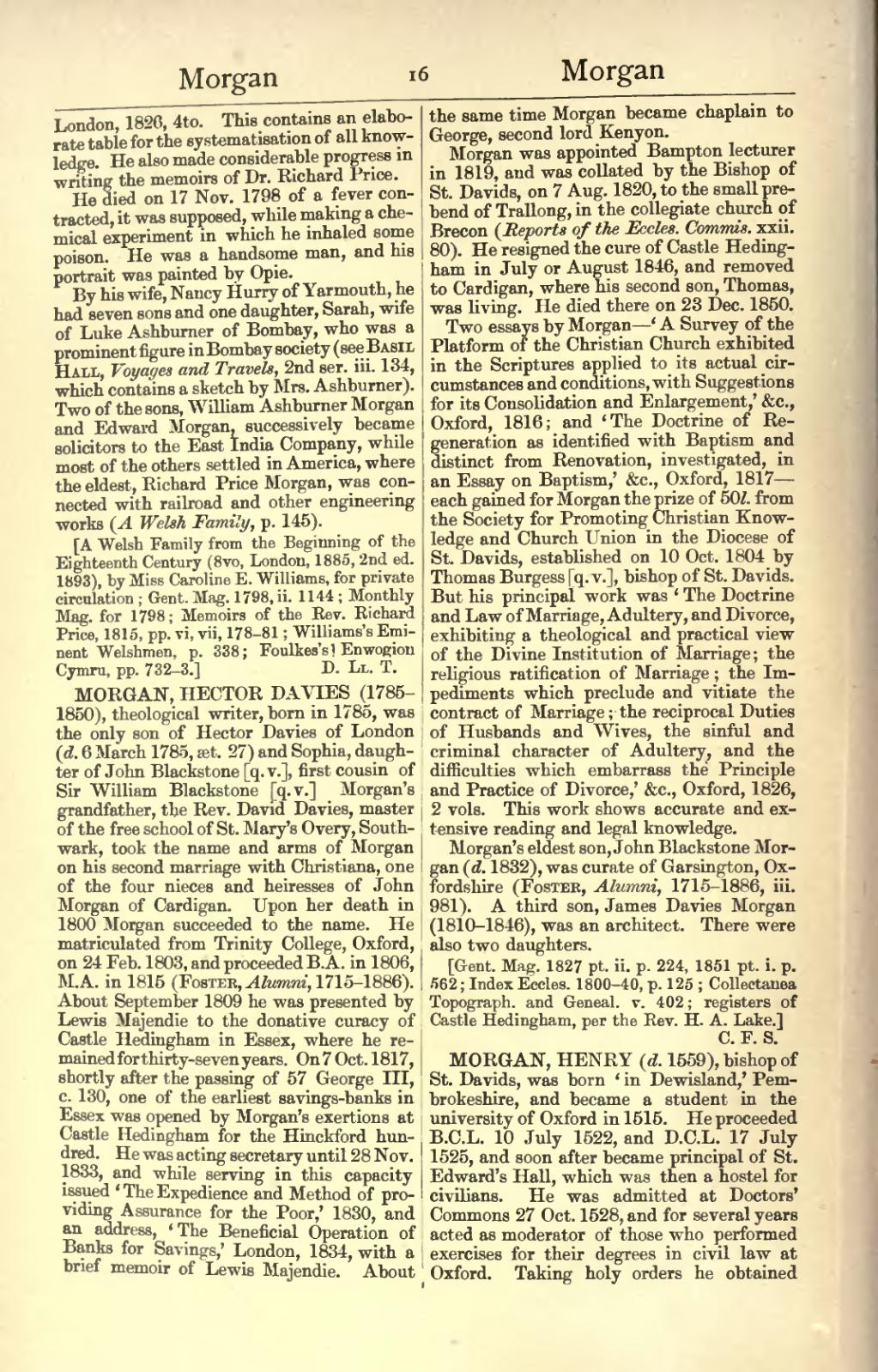London, 1826, 4to. This contains an elaborate table for the systematisation of all knowledge. He also made considerable progress in writing the memoirs of Dr. Richard Price.
He died on 17 Nov. 1798 of a fever contracted, it was supposed, while making a chemical experiment in which he inhaled some poison. He was a handsome man, and his portrait was painted by Opie.
By his wife, Nancy Hurry of Yarmouth, he had seven sons and one daughter, Sarah, wife of Luke Ashburner of Bombay, who was a prominent figure in Bombay society (see Basil Hall, Voyages and Travels, 2nd ser. iii. 134, which contains a sketch by Mrs. Ashburner). Two of the sons, William Ashburner Morgan and Edward Morgan, successively became solicitors to the East India Company, while most of the others settled in America, where the eldest, Richard Price Morgan, was connected with railroad and other engineering works (A Welsh Family, p. 145).
[A Welsh Family from the Beginning of the Eighteenth Century (8vo, London, 1885, 2nd ed. 1893), by Miss Caroline E. Williams, for private circulation; Gent. Mag. 1798, ii. 1144; Monthly Mag. for 1798; Memoirs of the Rev. Richard Price, 1815, pp. vi, vii, 178-81; Williams's Eminent Welshmen, p. 338; Foulkes'sl Enwogion Cymru, pp. 732-3.]
MORGAN, HECTOR DAVIES (1785–1850), theological writer, born in 1785, was the only son of Hector Davies of London (d. 6 March 1785, set. 27) and Sophia, daughter of John Blackstone [q. v.], first cousin of Sir William Blackstone [q.v.] Morgan's grandfather, the Rev. David Davies, master of the free school of St. Mary's Overy, Southwark, took the name and arms of Morgan on his second marriage with Christiana, one of the four nieces and heiresses of John Morgan of Cardigan. Upon her death in 1800 Morgan succeeded to the name. He matriculated from Trinity College, Oxford, on 24 Feb. 1803, and proceeded B.A. in 1806, M.A. in 1815 (Foster, Alumni, 1715-1886). About September 1809 he was presented by Lewis Majendie to the donative curacy of Castle Hedingham in Essex, where he remained for thirty-seven years. On 7 Oct. 1817, shortly after the passing of 57 George III, c. 130, one of the earliest savings-banks in Essex was opened by Morgan's exertions at Castle Hedingham for the Hinckford hundred. He was acting secretary until 28 Nov. 1833, and while serving in this capacity issued 'The Expedience and Method of providing Assurance for the Poor,' 1830, and an address, 'The Beneficial Operation of Banks for Savings,' London, 1834, with a brief memoir of Lewis Majendie. About the same time Morgan became chaplain to George, second lord Kenyon.
Morgan was appointed Bampton lecturer in 1819, and was collated by the Bishop of St. Davids, on 7 Aug. 1820, to the small prebend of Trallong, in the collegiate church of Brecon (Reports of the Eccles. Commis. xxii. 80). He resigned the cure of Castle Hedingham in July or August 1846, and removed to Cardigan, where his second son, Thomas, was living. He died there on 23 Dec. 1850.
Two essays by Morgan 'A Survey of the Platform of the Christian Church exhibited in the Scriptures applied to its actual circumstances and conditions, with Suggestions for its Consolidation and Enlargement,' &c., Oxford, 1816; and 'The Doctrine of Regeneration as identified with Baptism and distinct from Renovation, investigated, in an Essay on Baptism,' &c., Oxford, 1817 each gained for Morgan the prize of 501. from the Society for Promoting Christian Knowledge and Church Union in the Diocese of St. Davids, established on 10 Oct. 1804 by Thomas Burgess [q. v.], bishop of St. Davids. But his principal work was 'The Doctrine and Law of Marriage, Adultery, and Divorce, exhibiting a theological and practical view of the Divine Institution of Marriage; the religious ratification of Marriage; the Impediments which preclude and vitiate the contract of Marriage; the reciprocal Duties of Husbands and Wives, the sinful and criminal character of Adultery, and the difficulties which embarrass the Principle and Practice of Divorce,' &c., Oxford, 1826, 2 vols. This work shows accurate and extensive reading and legal knowledge.
Morgan's eldest son, John Blackstone Morgan (d. 1832), was curate of Garsington, Oxfordshire (Foster, Alumni, 1715-1886, iii. 981). A third son, James Davies Morgan (1810-1846), was an architect. There were also two daughters.
[Gent. Mag. 1827 pt. ii. p. 224, 1851 pt. i. p. 562; Index Eccles. 1800-40, p. 125; Collectanea Topograph. and Geneal. v. 402; registers of Castle Hedingham, per the Rev. H. A. Lake.]
MORGAN, HENRY (d. 1559), bishop of St. Davids, was born 'in Dewisland,' Pembrokeshire, and became a student in the university of Oxford in 1515. He proceeded B.C.L. 10 July 1522, and D.C.L. 17 July 1525, and soon after became principal of St. Edward's Hall, which was then a hostel for civilians. He was admitted at Doctors' Commons 27 Oct. 1528, and for several years acted as moderator of those who performed exercises for their degrees in civil law at Oxford. Taking holy orders he obtained
